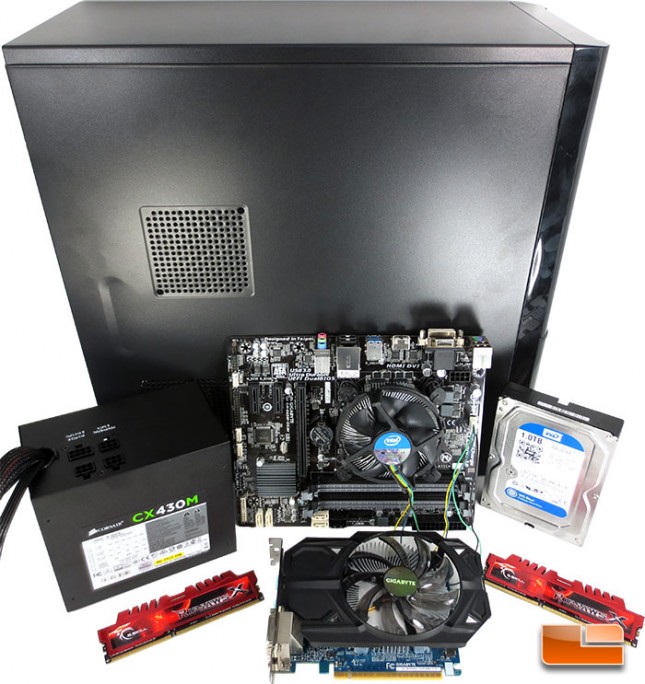Steambox Part 3 – Installing Windows 8.1 and General System Performance
Final Thoughts & Conclusion

Overall I’ve gotta say that I’m pretty impressed by the hardware that I used for the Steambox. Is this the worlds greatest gaming system, not by a long shot. It was never meant to be that. What I was trying to do is build a system that would be comparably priced to the latest console systems, while still being able to game. For the most part I would say that I succeeded. The total cost of the build after all is said and done is only $359.18, which is $40 less than either the Xbox One, or the PlayStation 4.
| Component | Amazon.com | Newegg.com | |
| Motherboard | GIGABYTE GA-B85M-DS3H | $55.99 | $45.99 AR ($10) |
| Processor | Intel Pentium G3258 | $69.99 | $69.99 |
| Graphics Card | GIGABYTE GeForce GTX750OC 2GB | $109.99 | $94.99 AR ($15) |
| Memory | G.Skill Ripjaws X 4GB (F3-12800CL9D-4GBXL) | $48.96 | $38.24 |
| Hard Drive | Western Digital Blue 1 Terabyte HDD | $54.99 | $54.99 |
| Chassis | GIGABYTE GZ-F3HEB PC Case | $29.99 | $29.99 |
| Power Supply | Corsair CX430M Modular Power Supply | $44.99 | $24.99 AR($20) |
| Total Cost: | $414.90 | $359.18 AR($45) | |
Below you can find the build log as well as the installation log for the SteamOS.
The problem with the build, or at least with the initial plans, lays with the Operating system. I’m not sold on the SteamOS just yet. Does it have some perks to it, sure it does. For many of us, a free and easy to use operating system is a great choice. Unfortunately there isn’t quite enough functionality with it just yet. Once I installed the SteamOS onto the system last week, I was a little disappointed by the lack of games support. Only about 16% of the 9000+ games in the Steam Library are supported by the SteamOS. They are working on adding more daily, but it’s more than just the lack of games. Granted, it does give us the ability to stream the Windows supported games to the SteamOS from a Windows machine on the same network, but that sort defeats the purpose. Running the SteamOS also limits us strictly to Steam games. As a gamer myself, there are a number of games that I play that aren’t available on Steam that I wouldn’t be able to play on this system, and that is a bit of a buzz kill!
Aside from games, the SteamOS is limited in its overall functionality. I was hoping that I would be able to use the Steambox as a HTPC and stream to my TV with Netflix through my Comcast XFinity, but I wasn’t able to get either of them to work in the SteamOS web browser. I did find out later that there are ways to get it to work using Google Chrome, but it’s not officially supported. Each of the concerns I have with the SteamOS, is remedied by running Steam in Windows. All of the games are available, Streaming movies isn’t an issue, and as much as I hate to admit it, Windows is a better experience at this point in time.
Tossing my concerns about the SteamOS off to the side, I wanted to be able to benchmark the hardware that I chose for the Steambox. Overall I’d say that the system is a pretty decent gaming system. The GIGABYTE GeForce GTX750OC 2GB card was able to power through all of the games without to much of an issue. Running the games with the Ultra settings was a touch to much for for the GIGABYTE GeForce GTX750OC graphics card, but lowering the settings to medium was a little to easy on the card. There is no doubt a sweet spot somewhere between the two settings that will be ideal for this system.
If you’re working on a budget, a system like this is the way to go. Sure it would be nice to add in a SSD for a boot drive, a more powerful processor or graphics card, but sometimes that’s just not in the budget. If I were to pick one piece of hardware that I could put some extra money into, I think it would be the graphics card. As newer games come out, the added horsepower of a faster GPU may come in handy down the line, though the same could be said about the processor. To be honest though, I have looked at the performance of the Intel Pentium G3258 as well as the Intel Pentium G3220, and both of them have held their own in gaming when paired with a good graphics card.
The trick about keeping the build cost down is the operating system. I really had hopes that the SteamOS would be more than it is. Unfortunately it really isn’t anything more than the Steam Big Picture mode that we can get in Windows. Outside of the fact that you don’t need Windows to run SteamOS, I don’t see much of a benefit to it at this point in time. Adding Windows to the mix will give the system considerable more functionality, as well as allowing you to play non Steam games.
Legit Bottom Line: While the hardware that I used for the Steambox build is definitely solid enough to be called a gaming rig, I think I’m going to stick to running Steam inside Windows. Having the added abilities in Windows is well worth the cost of a license to me. If I’m going to spend $50-$60+ on the latest games, I really shouldn’t have to much of an issue dropping $100 or so on an operating system that will get me the best performance and most use out of the system.
